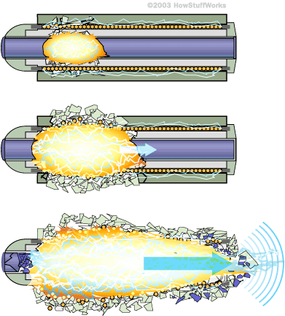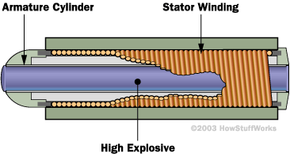Non-nuclear EMP Weapons
The United States has NNEMP weapons in its arsenal. Much of the United States' EMP research has involved high-power microwaves (HPMs) that are like super powerful microwave ovens that can generate a concentrated beam of microwave energy. In 2012, the U.S. Air Force successfully demonstrated a missile equipped with tech from the Counter-Electronics High Power Microwave Advanced Missile Project (CHAMP). An improved version of that weapon — the High-Powered Joint Electromagnetic Non-Kinetic Strike Weapon (HiJENKS) — was being tested as of 2022.
Non-nuclear EMPs can also come in the form of flux compression generator bombs (FCGs), which date back to the 1950s. This sort of EMP bomb has a fairly simple design, illustrated below. The bomb consists of a metal cylinder (called the armature), which is surrounded by a coil of wire (the stator winding). The armature cylinder is filled with high explosive, and a sturdy jacket surrounds the entire device. The stator winding and the armature cylinder are separated by empty space. The bomb also has a power source, such as a bank of capacitors, which can be connected to the stator.
Advertisement
Here's the sequence of events when the bomb goes off:
- A switch connects the capacitors to the stator, sending an electrical current through the wires. This generates an intense magnetic field.
- A fuze mechanism ignites the explosive material. The explosion travels as a wave through the middle of the armature cylinder.
- As the explosion makes its way through the cylinder, the cylinder comes in contact with the stator winding. This creates a short circuit, cutting the stator off from its power supply.
- The moving short circuit compresses the magnetic field, generating an intense electromagnetic burst.

Most likely, this type of weapon would affect a relatively small area — nothing on the order of a nuclear EMP attack — but it could do some serious damage.
In the next section, we'll look at some possible effects of an EMP attack.
